英语修辞手法总结(双语)
英语修辞学中20种常见修辞格名称双语释义及举例
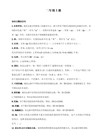
What does that lawyer do after he dies?——Lie still. 那个律师死后干什么?──躺着仍说鬼话。(注:lie躺, 撒谎;still安静地, 仍然)
E. oxymoron; zeugma ; contrast
Oxymoron(矛盾修辞法)与汉语中的反映辞格类似,都是将相互矛盾的概念和判断巧妙地联系在一起,以便相互映衬,突出事物的特点,表达复杂的思想感情和意味深长的哲理。矛盾修辞手法在英语中常见,但在汉语中很少见。如:sweet sorrow 忧喜参半 (不是甜蜜的悲伤); proud humility 不卑不亢(不是骄傲的谦卑)
这个项目从一开始就是一个摆脱不了的经济难题。(Albatross是英国诗人柯勒律治的《古舟子咏》中的信天翁,它被忘恩负义的水手杀死后,全船陷入灾难中。)
B. metonymy; transferred epithet Metonymy、synecdoche和_1antonomasia都是不直接说出事物的本来名称,而换用另一个名称或另一个说法。它们大体上相当于汉语的借代(分为旁借和对代两类)。如Crown(王冠)可喻指君主、王权、王国政府等;doll(玩具)可喻指姑娘、宝贝等。再如:
as thick as thieves亲密无间(不是"像贼一样厚")
as old as the hills古老 (不是"像山一样老")
The ship plows the sea. 船在乘风破浪地前进。(不是"船在犁海")
Allusion与汉语的暗引相近似。其特点是不注明来源和出处,一般多引用人们熟知的关键词或词组,将其融合编织在作者的话语中。引用的东西包括典故、谚语、成语、格言和俗语等。英语引用最多的是源出《圣经》故事以及希腊、罗马神话、《伊索寓言》和那些渊源流长的谚语、格言等。例如:
英语中的修辞手法及英英释义
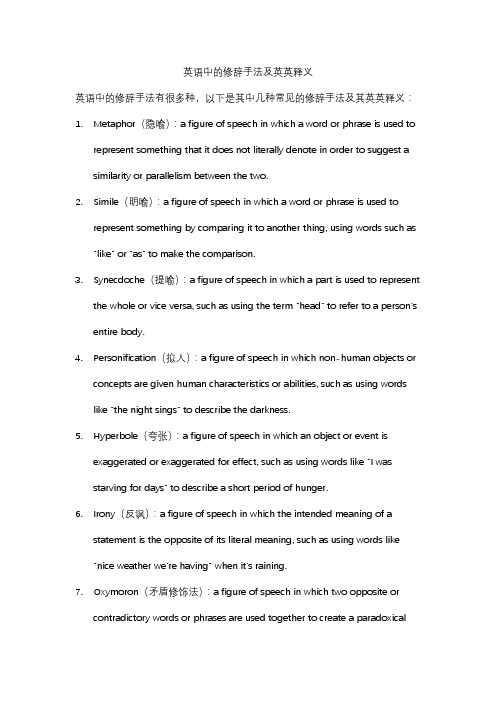
英语中的修辞手法及英英释义英语中的修辞手法有很多种,以下是其中几种常见的修辞手法及其英英释义:1.Metaphor(隐喻):a figure of speech in which a word or phrase is used torepresent something that it does not literally denote in order to suggest a similarity or parallelism between the two.2.Simile(明喻):a figure of speech in which a word or phrase is used torepresent something by comparing it to another thing, using words such as "like" or "as" to make the comparison.3.Synecdoche(提喻):a figure of speech in which a part is used to representthe whole or vice versa, such as using the term "head" to refer to a person's entire body.4.Personification(拟人):a figure of speech in which non-human objects orconcepts are given human characteristics or abilities, such as using words like "the night sings" to describe the darkness.5.Hyperbole(夸张):a figure of speech in which an object or event isexaggerated or exaggerated for effect, such as using words like "I wasstarving for days" to describe a short period of hunger.6.Irony(反讽):a figure of speech in which the intended meaning of astatement is the opposite of its literal meaning, such as using words like"nice weather we're having" when it's raining.7.Oxymoron(矛盾修饰法):a figure of speech in which two opposite orcontradictory words or phrases are used together to create a paradoxicaleffect, such as using words like "bittersweet" to describe a mixed feeling of happiness and sadness.这些修辞手法都可以增强语言的表达力,帮助传达更深刻的意义。
英文修辞手法介绍
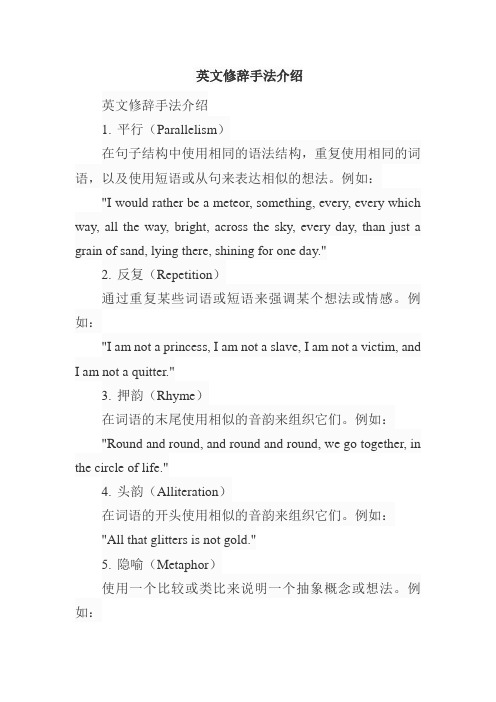
英文修辞手法介绍英文修辞手法介绍1. 平行(Parallelism)在句子结构中使用相同的语法结构,重复使用相同的词语,以及使用短语或从句来表达相似的想法。
例如:"I would rather be a meteor, something, every, every which way, all the way, bright, across the sky, every day, than just a grain of sand, lying there, shining for one day."2. 反复(Repetition)通过重复某些词语或短语来强调某个想法或情感。
例如:"I am not a princess, I am not a slave, I am not a victim, andI am not a quitter."3. 押韵(Rhyme)在词语的末尾使用相似的音韵来组织它们。
例如:"Round and round, and round and round, we go together, in the circle of life."4. 头韵(Alliteration)在词语的开头使用相似的音韵来组织它们。
例如:"All that glitters is not gold."5. 隐喻(Metaphor)使用一个比较或类比来说明一个抽象概念或想法。
例如:"He is a lion in battle."6. 明喻(Simile)使用像“像”或“如同”这样的词语来比较两个不同的事物或概念。
例如:"She sings like a bird."7. 反问(Rhetorical question)使用一个问题来表达一个陈述或观点,而不是提出真正的问题。
(完整版)英语中的修辞手法
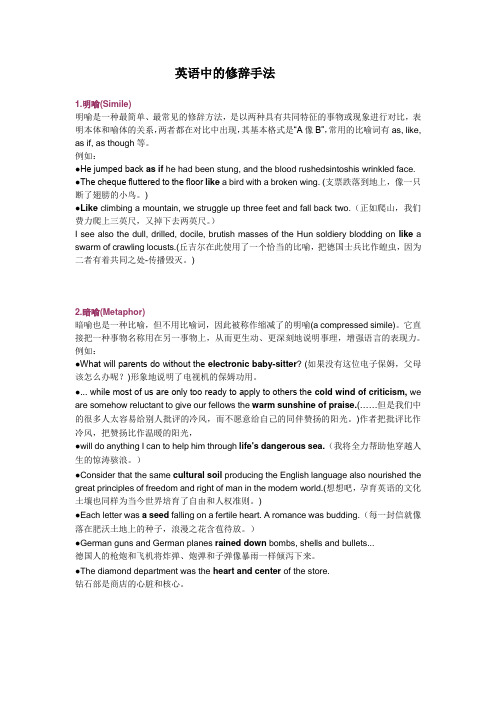
英语中的修辞手法1.明喻(Simile)明喻是一种最简单、最常见的修辞方法,是以两种具有共同特征的事物或现象进行对比,表明本体和喻体的关系,两者都在对比中出现,其基本格式是“A像B”,常用的比喻词有as, like, as if, as though等。
例如:●He jumped back as if he had been stung, and the blood rushedsintoshis wrinkled face.●The cheque fluttered to the floor like a bird with a broken wing. (支票跌落到地上,像一只断了翅膀的小鸟。
)●Like climbing a mountain, we struggle up three feet and fall back two.(正如爬山,我们费力爬上三英尺,又掉下去两英尺。
)I see also the dull, drilled, docile, brutish masses of the Hun soldiery blodding on like a swarm of crawling locusts.(丘吉尔在此使用了一个恰当的比喻,把德国士兵比作蝗虫,因为二者有着共同之处-传播毁灭。
)2.暗喻(Metaphor)暗喻也是一种比喻,但不用比喻词,因此被称作缩减了的明喻(a compressed simile)。
它直接把一种事物名称用在另一事物上,从而更生动、更深刻地说明事理,增强语言的表现力。
例如:●What will parents do without the electronic baby-sitter? (如果没有这位电子保姆,父母该怎么办呢?)形象地说明了电视机的保姆功用。
●... while most of us are only too ready to apply to others the cold wind of criticism, we are somehow reluctant to give our fellows the warm sunshine of praise.(……但是我们中的很多人太容易给别人批评的冷风,而不愿意给自己的同伴赞扬的阳光。
英语修辞手法及例句

英语修辞手法及例句一、明喻(simile)是以两种具有相同特征的事物和现象进行对比,表明本体和喻体之间的相似关系,两者都在对比中出现。
常用比喻词like, as, as if, as though等,例如:1、This elephant is like a snake as anybody can see.这头象和任何人见到的一样像一条蛇。
2、He looked as if he had just stepped out of my book of fairytales and had passed me like a spirit.他看上去好像刚从我的童话故事书中走出来,像幽灵一样从我身旁走过去。
3、It has long leaves that sway in the wind like slim fingers reaching to touch something.它那长长的叶子在风中摆动,好像伸出纤细的手指去触摸什么东西似的。
二、隐喻(metaphor)这种比喻不通过比喻词进行,而是直接将用事物当作乙事物来描写,甲乙两事物之间的联系和相似之处是暗含的。
1、The diamond department was the heart and center of the store.钻石部是商店的心脏和核心。
2.He is a pig.他简直是头猪。
(比喻:他是一个像猪一般的人,指肮脏,贪吃的人。
)3.She is a woman with a stony heart.她是一个铁石心肠的女人。
(比喻:这个女人冷酷无情。
)3.Mark Twain is a mirror of America.马克•吐温是美国的一面镜子。
(用镜子比喻美国的现实,很贴切。
)三、提喻(synecdoche)提喻是不直接说某一事物的名称,而是借事物的本身所呈现的各种对应的现象来表现该事物的这样一种修辞手段。
换喻主要借助于密切的关系与联想,而提喻则是借助于部分相似。
十九种英语修辞手法的详细解释和例句
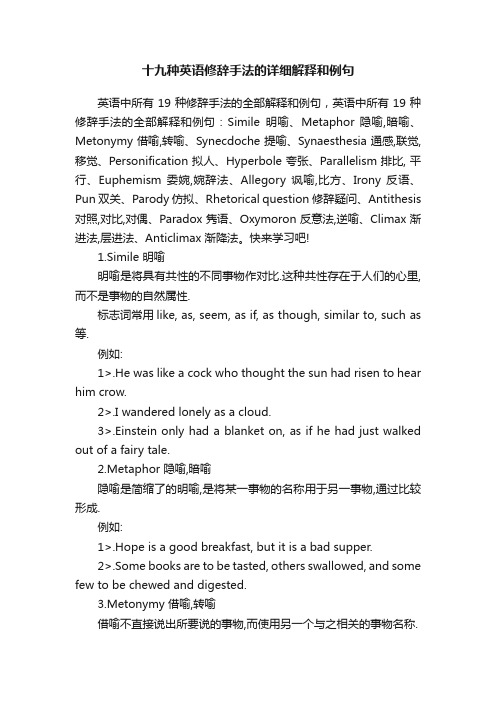
十九种英语修辞手法的详细解释和例句英语中所有19种修辞手法的全部解释和例句,英语中所有19种修辞手法的全部解释和例句:Simile明喻、Metaphor 隐喻,暗喻、Metonymy 借喻,转喻、Synecdoche 提喻、Synaesthesia 通感,联觉,移觉、Personification 拟人、Hyperbole 夸张、Parallelism 排比, 平行、Euphemism 委婉,婉辞法、Allegory 讽喻,比方、Irony 反语、Pun 双关、Parody 仿拟、Rhetorical question 修辞疑问、Antithesis 对照,对比,对偶、Paradox 隽语、Oxymoron 反意法,逆喻、Climax 渐进法,层进法、Anticlimax 渐降法。
快来学习吧!1.Simile 明喻明喻是将具有共性的不同事物作对比.这种共性存在于人们的心里,而不是事物的自然属性.标志词常用like, as, seem, as if, as though, similar to, such as 等.例如:1>.He was like a cock who thought the sun had risen to hear him crow.2>.I wandered lonely as a cloud.3>.Einstein only had a blanket on, as if he had just walked out of a fairy tale.2.Metaphor 隐喻,暗喻隐喻是简缩了的明喻,是将某一事物的名称用于另一事物,通过比较形成.例如:1>.Hope is a good breakfast, but it is a bad supper.2>.Some books are to be tasted, others swallowed, and some few to be chewed and digested.3.Metonymy 借喻,转喻借喻不直接说出所要说的事物,而使用另一个与之相关的事物名称.I.以容器代替内容,例如:1>.The kettle boils. 水开了.2>.The room sat silent. 全屋人安静地坐着.II.以资料.工具代替事物的名称,例如:Lend me your ears, please. 请听我说.III.以作者代替作品,例如:a complete Shakespeare 莎士比亚全集VI.以具体事物代替抽象概念,例如:I had the muscle, and they made money out of it. 我有力气,他们就用我的力气赚钱.4.Synecdoche 提喻提喻用部分代替全体,或用全体代替部分,或特殊代替一般.例如:1>.There are about 100 hands working in his factory.(部分代整体)他的厂里约有100名工人.2>.He is the Newton of this century.(特殊代一般)他是本世纪的牛顿.3>.The fox goes very well with your cap.(整体代部分)这狐皮围脖与你的帽子很相配.5.Synaesthesia 通感,联觉,移觉这种修辞法是以视.听.触.嗅.味等感觉直接描写事物.通感就是把不同感官的感觉沟通起来,借联想引起感觉转移,“以感觉写感觉”。
英语作文中的常见修辞手法
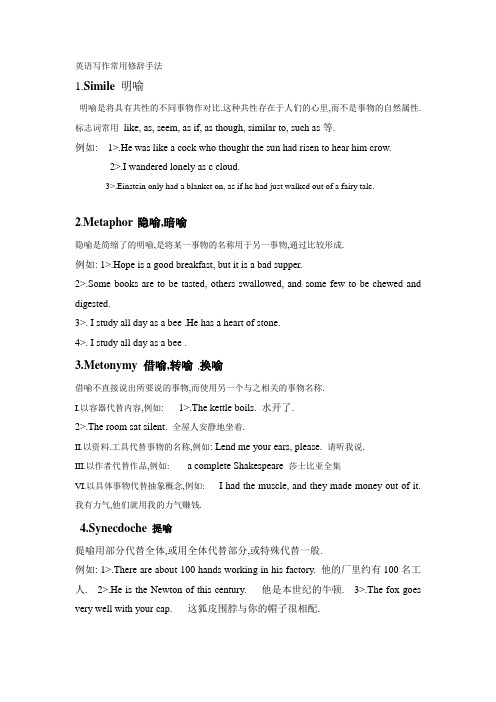
英语写作常用修辞手法1.Simile明喻明喻是将具有共性的不同事物作对比.这种共性存在于人们的心里,而不是事物的自然属性. 标志词常用like, as, seem, as if, as though, similar to, such as等.例如: 1>.He was like a cock who thought the sun had risen to hear him crow.2>.I wandered lonely as c cloud.3>.Einstein only had a blanket on, as if he had just walked out of a fairy tale.2.Metaphor隐喻,暗喻隐喻是简缩了的明喻,是将某一事物的名称用于另一事物,通过比较形成.例如: 1>.Hope is a good breakfast, but it is a bad supper.2>.Some books are to be tasted, others swallowed, and some few to be chewed and digested.3>. I study all day as a bee .He has a heart of stone.4>. I study all day as a bee .3.Metonymy 借喻,转喻,换喻借喻不直接说出所要说的事物,而使用另一个与之相关的事物名称.I.以容器代替内容,例如: 1>.The kettle boils. 水开了.2>.The room sat silent. 全屋人安静地坐着.II.以资料.工具代替事物的名称,例如: Lend me your ears, please. 请听我说.III.以作者代替作品,例如: a complete Shakespeare 莎士比亚全集VI.以具体事物代替抽象概念,例如: I had the muscle, and they made money out of it. 我有力气,他们就用我的力气赚钱.4.Synecdoche提喻提喻用部分代替全体,或用全体代替部分,或特殊代替一般.例如: 1>.There are about 100 hands working in his factory. 他的厂里约有100名工人. 2>.He is the Newton of this century. 他是本世纪的牛顿. 3>.The fox goes very well with your cap. 这狐皮围脖与你的帽子很相配.5.Personification 拟人拟人是把生命赋予无生命的事物.例如: 1>.The night gently lays her hand at our fevered heads.2>.I was very happy and could hear the birds singing in the woods.6.Irony 反语反语指用相反意义的词来表达意思的作文方式.如在指责过失.错误时,用赞同过失的说法,而在表扬时,则近乎责难的说法.例如: 1>.It would be a fine thing indeed not knowing what time it was in the morning. 2>"Of course, you only carry large notes, no small change on you. "the waiter said to the beggar..Allegory讽喻,比方这是一种源于希腊文的修辞法,意为"换个方式的说法".它是一种形象的描述,具有双重性,表层含义与真正意味的是两回事.例如: 1>.Make the hay while the sun shines.2>.It's time to turn plough into sword.7.Hyperbole 夸张overstatement understatement夸张是以言过其实的说法表达强调的目的.它可以加强语势,增加表达效果..例如: 1>.I beg a thousand pardons.2>.Love you. You are the whole world to me, and the moon and the stars.3>.When she heard the bad news, a river of tears poured out.8.Euphemism 委婉,婉辞法婉辞法指用委婉,文雅的方法表达粗恶,避讳的话. 例如:1>.He is out visiting the necessary. 他出去方便一下.2>.His relation with his wife has not been fortunate. 他与妻子关系不融洽.3>.Deng Xiaoping passed away in 19979. 移位修饰transferred epithet将本应该用来修饰某一类名词的修饰语用来修饰另一类名词。
15种修辞方法及例句英文
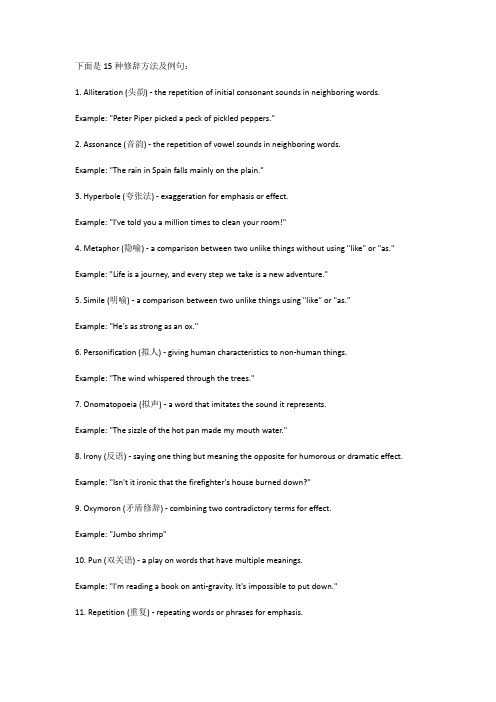
下面是15种修辞方法及例句:1. Alliteration (头韵) - the repetition of initial consonant sounds in neighboring words. Example: "Peter Piper picked a peck of pickled peppers."2. Assonance (音韵) - the repetition of vowel sounds in neighboring words.Example: "The rain in Spain falls mainly on the plain."3. Hyperbole (夸张法) - exaggeration for emphasis or effect.Example: "I've told you a million times to clean your room!"4. Metaphor (隐喻) - a comparison between two unlike things without using "like" or "as." Example: "Life is a journey, and every step we take is a new adventure."5. Simile (明喻) - a comparison between two unlike things using "like" or "as." Example: "He's as strong as an ox."6. Personification (拟人) - giving human characteristics to non-human things.Example: "The wind whispered through the trees."7. Onomatopoeia (拟声) - a word that imitates the sound it represents.Example: "The sizzle of the hot pan made my mouth water."8. Irony (反语) - saying one thing but meaning the opposite for humorous or dramatic effect. Example: "Isn't it ironic that the firefighter's house burned down?"9. Oxymoron (矛盾修辞) - combining two contradictory terms for effect.Example: "Jumbo shrimp"10. Pun (双关语) - a play on words that have multiple meanings.Example: "I'm reading a book on anti-gravity. It's impossible to put down."11. Repetition (重复) - repeating words or phrases for emphasis.Example: "I have a dream..."12. Rhetorical Question (反问) - a question asked for effect, not meant to be answered. Example: "Can't we all just get along?"13. Parallelism (排比) - using similar grammatical structures to emphasize a point. Example: "We came, we saw, we conquered."14. Allusion (典故) - referring to something well-known in history, literature, or culture. Example: "She has the wisdom of Solomon."15. Antithesis (对偶) - contrasting two ideas or phrases for effect.Example: "It was the best of times, it was the worst of times."。
英文中最常见的20种修辞手法(解释例句)
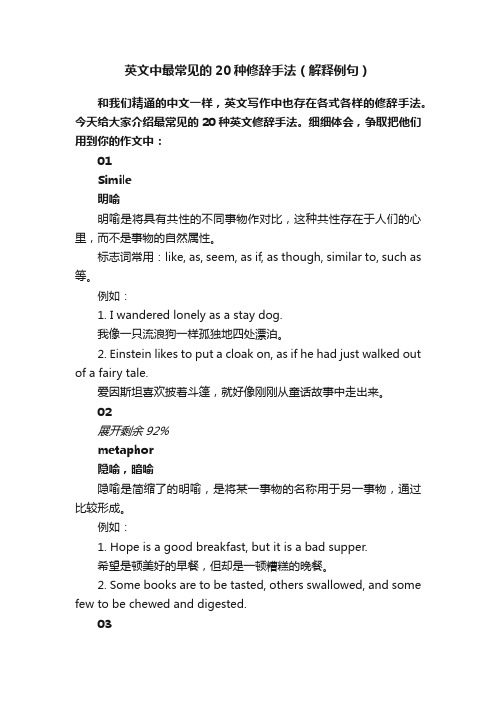
英文中最常见的20种修辞手法(解释例句)和我们精通的中文一样,英文写作中也存在各式各样的修辞手法。
今天给大家介绍最常见的20种英文修辞手法。
细细体会,争取把他们用到你的作文中:01Simile明喻明喻是将具有共性的不同事物作对比,这种共性存在于人们的心里,而不是事物的自然属性。
标志词常用:like, as, seem, as if, as though, similar to, such as 等。
例如:1. I wandered lonely as a stay dog.我像一只流浪狗一样孤独地四处漂泊。
2. Einstein likes to put a cloak on, as if he had just walked out of a fairy tale.爱因斯坦喜欢披着斗篷,就好像刚刚从童话故事中走出来。
02展开剩余92%metaphor隐喻,暗喻隐喻是简缩了的明喻,是将某一事物的名称用于另一事物,通过比较形成。
例如:1. Hope is a good breakfast, but it is a bad supper.希望是顿美好的早餐,但却是一顿糟糕的晚餐。
2. Some books are to be tasted, others swallowed, and some few to be chewed and digested.03metonymy借喻,转喻借喻不直接说出所要说的事物,而使用另一个与之相关的事物名称.1. 以容器代替内容,例如:1)The kettle boils.水开了。
2)The room sat silent.全屋人安静地坐着。
2. 以资料、工具代替事物的名称,例如:Lend me your ears, please.请听我说。
3. 以作者代替作品,例如:a complete Shakespeare莎士比亚全集4. 以具体事物代替抽象概念,例如:I had the muscle, and they made money out of it.我有力气,他们就用我的力气赚钱。
高级英语中的修辞手法总结带课文中例句
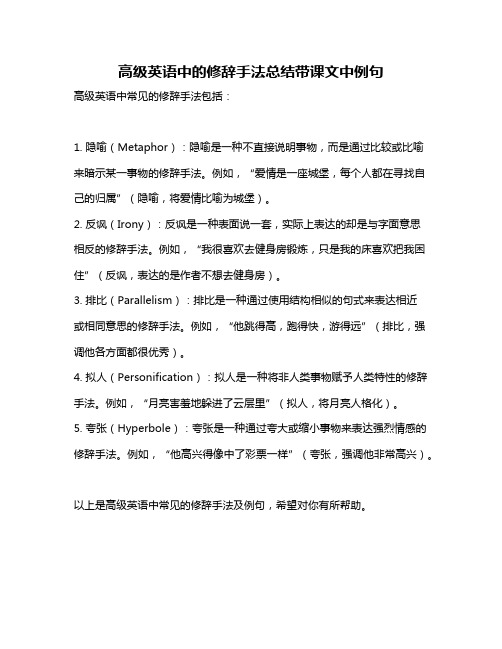
高级英语中的修辞手法总结带课文中例句
高级英语中常见的修辞手法包括:
1. 隐喻(Metaphor):隐喻是一种不直接说明事物,而是通过比较或比喻来暗示某一事物的修辞手法。
例如,“爱情是一座城堡,每个人都在寻找自己的归属”(隐喻,将爱情比喻为城堡)。
2. 反讽(Irony):反讽是一种表面说一套,实际上表达的却是与字面意思
相反的修辞手法。
例如,“我很喜欢去健身房锻炼,只是我的床喜欢把我困住”(反讽,表达的是作者不想去健身房)。
3. 排比(Parallelism):排比是一种通过使用结构相似的句式来表达相近
或相同意思的修辞手法。
例如,“他跳得高,跑得快,游得远”(排比,强调他各方面都很优秀)。
4. 拟人(Personification):拟人是一种将非人类事物赋予人类特性的修辞手法。
例如,“月亮害羞地躲进了云层里”(拟人,将月亮人格化)。
5. 夸张(Hyperbole):夸张是一种通过夸大或缩小事物来表达强烈情感的修辞手法。
例如,“他高兴得像中了彩票一样”(夸张,强调他非常高兴)。
以上是高级英语中常见的修辞手法及例句,希望对你有所帮助。
完整word版,英语修辞手法总结(双语),推荐文档

英语修辞手法总结Figures of speech (修辞)are ways of making our language figurative. When we use words in other than their ordinary or literal sense to lend force to an idea, to heighten effect, or to create suggestive imagery, we are said to be speaking or writing figuratively. Now we are going to talk about some common forms of figures of speech.1) Simile:(明喻)It is a figure of speech which makes a comparison between two unlike elements having at least one quality or characteristic (特性)in common. To make the comparison, words like as, as...as, as if and like are used to transfer the quality we associate with one to the other. For example, As cold waters to a thirsty soul, so is good news from a far country.2) Metaphor:(暗喻)It is like a simile, also makes a comparison between two unlike elements, but unlike a simile, this comparison is implied rather than stated. For example, the world is a stage. 3) Analogy: (类比)It is also a form of comparison, but unlike simile or metaphor which usually uses comparison on one point of resemblance, analogy draws a parallel between two unlike things that have several common qualities or points of resemblance.4) Personification: (拟人)It gives human form of feelings to animals, or life and personal attributes(赋予) to inanimate(无生命的) objects, or to ideas and abstractions(抽象). For example, the wind whistled through the trees.5) Hyperbole: (夸张)It is the deliberate use of overstatement or exaggeration to achieve emphasis. For instance, he almost died laughing.6) Understatement: (含蓄陈述)It is the opposite of hyperbole, or overstatement. It achieves its effect of emphasizing a fact by deliberately(故意地) understating it, impressing the listener or the reader more by what is merely implied or left unsaid than by bare statement. For instance, It is no laughing matter.7) Euphemism: (委婉)It is the substitution of an agreeable or inoffensive(无冒犯) expression for one that may offend or suggest something unpleasant. For instance, we refer to "die" as " pass away".8) Metonymy (转喻)It is a figure of speech that has to do with the substitution of the mane of one thing for that of another. For instance, the pen (words) is mightier than the sword (forces). 9) Synecdoche (提喻)It is involves the substitution of the part for the whole, or the whole for the part. For instance, they say there's bread and work for all. She was dressed in silks.10) Antonomasia (换喻)It has also to do with substitution. It is not often mentioned now, though it is still in frequent use. For example, Solomon for a wise man. Daniel for a wise and fair judge. Judas for a traitor.11) Pun: (双关语)It is a play on words, or rather a play on the form and meaning of words. For instance, a cannon-ball took off his legs, so he laid down his arms. (Here "arms" has two meanings: a person's body; weapons carried by a soldier.)12) Syllepsis: (一语双叙)It has two connotations.In the first case, it is a figure by which a word, or a particular form or inflection of a word, refers to two or more words in the same sentence, while properly applying to or agreeing with only on of them in grammar or syntax(句法). For example, He addressed you and me, and desired us to follow him. (Here us is used to refer to you and me.)In the second case, it a word may refer to two or more words in the same sentence. For example, while he was fighting , and losing limb and mind, and dying, others stayed behind topursue education and career. (Here to losing one's limbs in literal; to lose one's mind is figurative, and means to go mad.)13) Zeugma: (轭式搭配)It is a single word which is made to modify or to govern two or more words in the same sentence, wither properly applying in sense to only one of them, or applying to them in different senses. For example, The sun shall not burn you by day, nor the moon by night. (Here noon is not strong enough to burn)14) Irony: (反语)It is a figure of speech that achieves emphasis by saying the opposite of what is meant, the intended meaning of the words being the opposite of their usual sense. For instance, we are lucky, what you said makes me feel real good.15) Innuendo: (暗讽)It is a mild form of irony, hinting in a rather roundabout (曲折)way at something disparaging(不一致) or uncomplimentary(不赞美) to the person or subject mentioned. For example, the weatherman said it would be worm. He must take his readings in a bathroom. 16) Sarcasm: (讽刺)It Sarcasm is a strong form of irony. It attacks in a taunting and bitter manner, and its aim is to disparage, ridicule and wound the feelings of the subject attacked. For example, laws are like cobwebs, which may catch small flies, but let wasps break through.17) Paradox: (似非而是的隽语)It is a figure of speech consisting of a statement or proposition which on the face of it seems self-contradictory, absurd or contrary to established fact or practice, but which on further thinking and study may prove to be true, well-founded, and even to containa succinct point. For example more haste, less speed.18) Oxymoron: (矛盾修饰)It is a compressed paradox, formed by the conjoining(结合) of two contrasting, contradictory or incongruous(不协调) terms as in bitter-sweet memories, orderly chaos(混乱) and proud humility(侮辱).19) Antithesis: (对照)It is the deliberate arrangement of contrasting words or ideas in balanced structural forms to achieve emphasis. For example, speech is silver; silence is golden.20) Epigram: (警句)It states a simple truth pithily(有利地) and pungently(强烈地). It is usually terse and arouses interest and surprise by its deep insight into certain aspects of human behavior or feeling. For instance, Few, save the poor, feel for the poor.21) Climax: (渐进)It is derived from the Greek word for "ladder" and implies the progression of thought at a uniform or almost uniform rate of significance or intensity, like the steps of a ladder ascending evenly. For example, I came, I saw, I conquered.22) Anti-climax or bathos: (突降)It is the opposite of Climax. It involves stating one's thoughts ina descending order of significance or intensity, from strong to weak, from weighty to light or frivolous. For instance, But thousands die, without or this or that, die, and endow(赋予) a college, or a cat.23) Apostrophe:(顿呼)In this figure of speech, a thing, place, idea or person (dead or absent) is addressed as if present, listening and understanding what is being said. For instance, England! awake! awake! awake!24) Transferred Epithet: (转类形容词)It is a figure of speech where an epithet (an adjective or descriptive phrase) is transferred from the noun it should rightly modify(修饰) to another to which it does not really apply or belong. For instance, I spent sleepless nights on my project.25) Alliteration: (头韵)It has to do with the sound rather than the sense of words for effect. It isa device that repeats the same sound at frequent intervals(间隔) and since the sound repeated is usually the initial consonant sound, it is also called "front rhyme". For instance, the fair breeze blew, the white foam flew, the furrow followed free.26) Onomatopoeia: (拟声)It is a device that uses words which imitate the sounds made by an object (animate or inanimate), or which are associated with or suggestive(提示的) of some action or movementExplanation version1一、什么是修辞格修辞格(figures of speech)是提高语言表达效果的语言艺术。
20种英语修辞手法整理
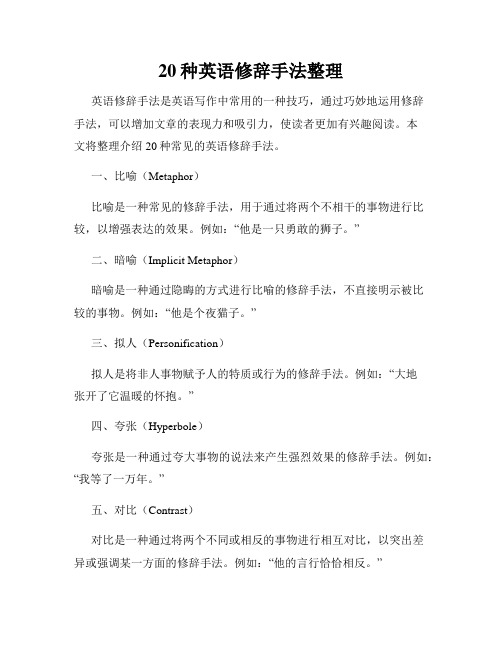
20种英语修辞手法整理英语修辞手法是英语写作中常用的一种技巧,通过巧妙地运用修辞手法,可以增加文章的表现力和吸引力,使读者更加有兴趣阅读。
本文将整理介绍20种常见的英语修辞手法。
一、比喻(Metaphor)比喻是一种常见的修辞手法,用于通过将两个不相干的事物进行比较,以增强表达的效果。
例如:“他是一只勇敢的狮子。
”二、暗喻(Implicit Metaphor)暗喻是一种通过隐晦的方式进行比喻的修辞手法,不直接明示被比较的事物。
例如:“他是个夜猫子。
”三、拟人(Personification)拟人是将非人事物赋予人的特质或行为的修辞手法。
例如:“大地张开了它温暖的怀抱。
”四、夸张(Hyperbole)夸张是一种通过夸大事物的说法来产生强烈效果的修辞手法。
例如:“我等了一万年。
”五、对比(Contrast)对比是一种通过将两个不同或相反的事物进行相互对比,以突出差异或强调某一方面的修辞手法。
例如:“他的言行恰恰相反。
”六、排比(Parallelism)排比是一种通过对句子或短语进行平行结构的修辞手法,以强调重点或增加语句的节奏感。
例如:“奋斗,拼搏,追求,努力。
”七、倒装(Inversion)倒装是一种颠倒语序的修辞手法,常常用于疑问句或为了强调某一部分。
例如:“Never have I seen such a beautiful sunset.”八、反问(Rhetorical Question)反问是一种用疑问句的形式表达肯定或否定的修辞手法,常用于强调某一观点或引起读者思考。
例如:“难道你不想成功吗?”九、比较(Comparison)比较是通过将两个事物进行对比,以凸显共同点或差异的修辞手法。
例如:“学习就像是爬山,充满了艰辛和挑战。
”十、设问(Hypophora)设问是一种在文章中提出问题,并在下文中进行回答的修辞手法,常用于引起读者的关注和思考。
例如:“你知道成功的秘诀是什么吗?答案很简单——努力。
英语13种修辞手法
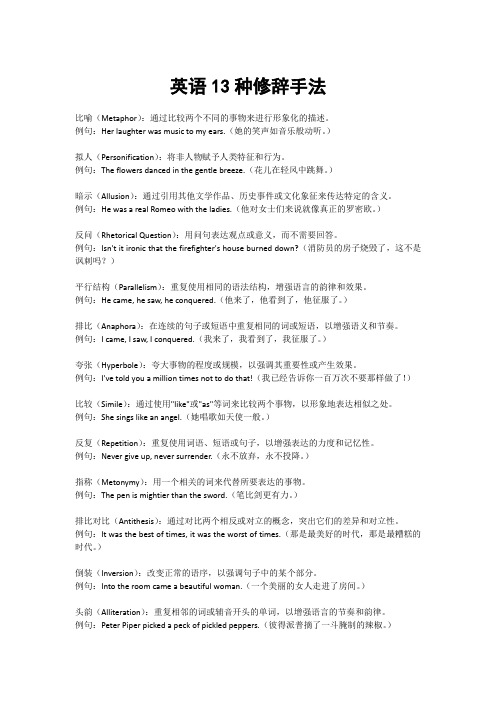
英语13种修辞手法比喻(Metaphor):通过比较两个不同的事物来进行形象化的描述。
例句:Her laughter was music to my ears.(她的笑声如音乐般动听。
)拟人(Personification):将非人物赋予人类特征和行为。
例句:The flowers danced in the gentle breeze.(花儿在轻风中跳舞。
)暗示(Allusion):通过引用其他文学作品、历史事件或文化象征来传达特定的含义。
例句:He was a real Romeo with the ladies.(他对女士们来说就像真正的罗密欧。
)反问(Rhetorical Question):用问句表达观点或意义,而不需要回答。
例句:Isn't it ironic that the firefighter's house burned down?(消防员的房子烧毁了,这不是讽刺吗?)平行结构(Parallelism):重复使用相同的语法结构,增强语言的韵律和效果。
例句:He came, he saw, he conquered.(他来了,他看到了,他征服了。
)排比(Anaphora):在连续的句子或短语中重复相同的词或短语,以增强语义和节奏。
例句:I came, I saw, I conquered.(我来了,我看到了,我征服了。
)夸张(Hyperbole):夸大事物的程度或规模,以强调其重要性或产生效果。
例句:I've told you a million times not to do that!(我已经告诉你一百万次不要那样做了!)比较(Simile):通过使用"like"或"as"等词来比较两个事物,以形象地表达相似之处。
例句:She sings like an angel.(她唱歌如天使一般。
)反复(Repetition):重复使用词语、短语或句子,以增强表达的力度和记忆性。
英语修辞手法举例中英文
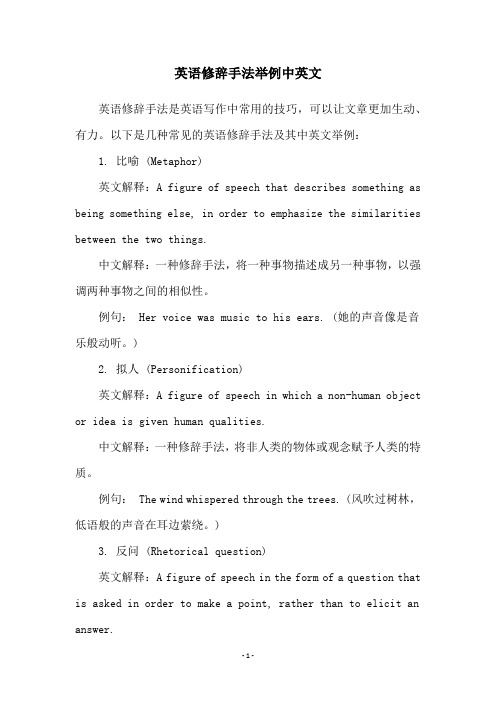
英语修辞手法举例中英文英语修辞手法是英语写作中常用的技巧,可以让文章更加生动、有力。
以下是几种常见的英语修辞手法及其中英文举例:1. 比喻 (Metaphor)英文解释:A figure of speech that describes something as being something else, in order to emphasize the similarities between the two things.中文解释:一种修辞手法,将一种事物描述成另一种事物,以强调两种事物之间的相似性。
例句: Her voice was music to his ears. (她的声音像是音乐般动听。
)2. 拟人 (Personification)英文解释:A figure of speech in which a non-human object or idea is given human qualities.中文解释:一种修辞手法,将非人类的物体或观念赋予人类的特质。
例句: The wind whispered through the trees. (风吹过树林,低语般的声音在耳边萦绕。
)3. 反问 (Rhetorical question)英文解释:A figure of speech in the form of a question that is asked in order to make a point, rather than to elicit an answer.中文解释:一种修辞手法,以问句的形式表达观点,而不是期望得到回答。
例句: Would you jump off a bridge just because your friends did? (你会因为朋友跳桥而跟随吗?)4. 排比 (Parallelism)英文解释:The use of similar grammatical structures, phrases or words to create a rhythmic and balanced effect.中文解释:一种修辞手法,使用相似的语法结构、短语或单词,以创造节奏感和平衡效果。
英文中的修辞手法
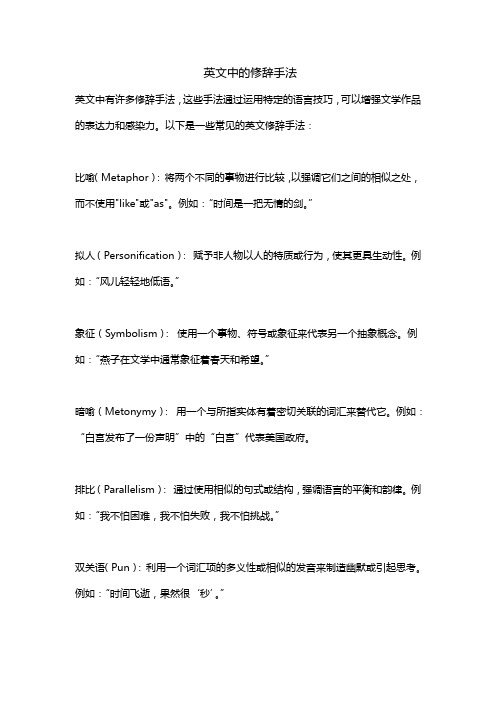
英文中的修辞手法英文中有许多修辞手法,这些手法通过运用特定的语言技巧,可以增强文学作品的表达力和感染力。
以下是一些常见的英文修辞手法:比喻(Metaphor):将两个不同的事物进行比较,以强调它们之间的相似之处,而不使用"like"或"as"。
例如:“时间是一把无情的剑。
”拟人(Personification):赋予非人物以人的特质或行为,使其更具生动性。
例如:“风儿轻轻地低语。
”象征(Symbolism):使用一个事物、符号或象征来代表另一个抽象概念。
例如:“燕子在文学中通常象征着春天和希望。
”暗喻(Metonymy):用一个与所指实体有着密切关联的词汇来替代它。
例如:“白宫发布了一份声明”中的“白宫”代表美国政府。
排比(Parallelism):通过使用相似的句式或结构,强调语言的平衡和韵律。
例如:“我不怕困难,我不怕失败,我不怕挑战。
”双关语(Pun):利用一个词汇项的多义性或相似的发音来制造幽默或引起思考。
例如:“时间飞逝,果然很‘秒’。
”讽刺(Irony):通过言辞上的反讽,表达与字面意义相反的意思。
例如:“这个‘伟大’的计划居然失败了。
”悬念(Suspense):通过保持某种信息的不明确,刺激读者的兴趣,以激发紧张感。
例如:“她打开门,里面的一切都让她惊呆了。
”对仗(Antithesis):将相对或对立的思想或概念通过并列的结构进行强调。
例如:“昨夜寒风凛冽,今朝暖阳明媚。
”比较(Simile):将两个事物通过使用"like"或"as"进行比较,以突显它们之间的相似之处。
例如:“她如同一朵盛开的花。
”这些修辞手法可以单独使用,也可以结合在一起,创造出更为复杂和富有表现力的文学效果。
作家通常根据他们的写作目的,选择最适合表达自己意图的修辞手法。
英语中常用的修辞手法

英语中常用的修辞手法英语中常用的修辞手法有以下几种:1. Simile(明喻):通过使用“like”或“as”等词将两个不同的事物进行比较,以突出它们的相似之处。
Example: Her eyes were like stars in the night sky.2. Metaphor(隐喻):将一个事物直接比作另一个事物,而不使用“like”或“as”等词。
Example: Life is a journey.3. Personification(拟人):赋予无生命的事物以人类的特征或行为。
Example: The wind whispered through the trees.4. Hyperbole(夸张):故意夸大或夸张某个事物的特征或程度。
Example: I could sleep for a year.5. Parallelism(排比):使用相同或相似的结构、语法或词汇来表达一个想法或主题。
Example: She is smart, talented, and beautiful.6. Alliteration(头韵):重复相同的声音或字母,以增强语言的韵律和节奏。
Example: The quick brown fox jumps over the lazy dog.7. Onomatopoeia(拟声):使用与所描述的声音相似的词汇来模拟声音。
Example: The clock tick-tocked in the quiet room.8. Repetition(重复):重复某个词汇或短语以增强语言的效果。
Example: Once upon a time, there was a princess who lived in a castle.9. Antithesis(对比):将两个相反的想法或概念放在一起进行对比。
Example: Love is an act of endless forgiveness, a tender look which becomes a habit.这些修辞手法可以帮助作者更生动、形象地表达自己的意思,增强语言的感染力和说服力。
英语动作描写修辞手法

英语动作描写修辞手法1.比喻(Simile)比喻是通过相似性将两个不同的事物进行比较,以强调其相似之处。
例如:“He runs like a deer.”(他跑得像只鹿。
)2.拟人(Personification)拟人是将非人的事物赋予人的特性或情感。
例如:“The sun smiled on the fields.”(太阳对田野微笑。
)3.借代(Metonymy)借代是用一个事物的名称代替另一个与之密切相关的事物的名称。
例如:“He put the key in the lock.”(他把钥匙插入锁中。
)4.对比(Antithesis)对比是将两个相对立的概念或情况放在一起对比。
例如:“Life is like a box of chocolates,you never know what you're gonna get.”(生活就像一盒巧克力,你永远不知道你会得到什么。
)5.反复(Repetition)反复是为了强调某个概念或感觉而重复使用某个词或短语。
例如:“Over and over again,he repeated the same story.”(他一遍又一遍地重复着同一个故事。
)6.夸张(Hyperbole)夸张是通过夸大事实来强调某个观点或情感。
例如:“I'm so hungry,I could eat a horse!”(我太饿了,可以吃下一匹马!)7.排比(Parallelism)排比是使用平行结构来组织语言,增强句子的节奏感和平衡感。
例如:“He was born,lived and died a soldier.”(他生为士兵,活为士兵,死为士兵。
)8.反语(Irony)反语是通过说反话来表达与字面意思相反的含义,通常是为了讽刺或强调。
例如:“That's the best part of the movie—the rest was just ok.”(那是电影最精彩的部分——其余的只是一般般。
英语最全修辞手法
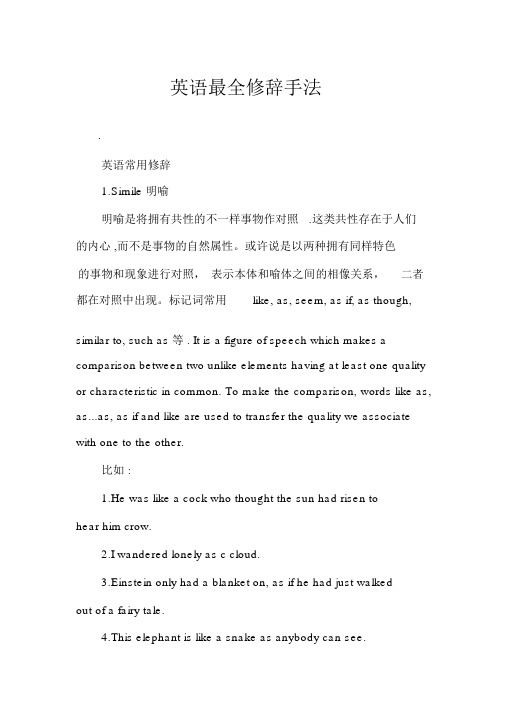
英语最全修辞手法.英语常用修辞1.Simile 明喻明喻是将拥有共性的不一样事物作对照.这类共性存在于人们的内心 ,而不是事物的自然属性。
或许说是以两种拥有同样特色的事物和现象进行对照,表示本体和喻体之间的相像关系,二者都在对照中出现。
标记词常用like, as, seem, as if, as though, similar to, such as 等 . It is a figure of speech which makes a comparison between two unlike elements having at least one quality or characteristic in common. To make the comparison, words like as, as...as, as if and like are used to transfer the quality we associate with one to the other.比如 :1.He was like a cock who thought the sun had risen tohear him crow.2.I wandered lonely as c cloud.3.Einstein only had a blanket on, as if he had just walkedout of a fairy tale.4.This elephant is like a snake as anybody can see.这头象和任何人见到的同样像一条蛇。
5.He looked as if he had just stepped out of my book of fairytales andhad passed me like a spirit.他看上去仿佛刚从我的童话故事书中走出来,像幽灵同样从我身边走过去。
英语30种修辞手法
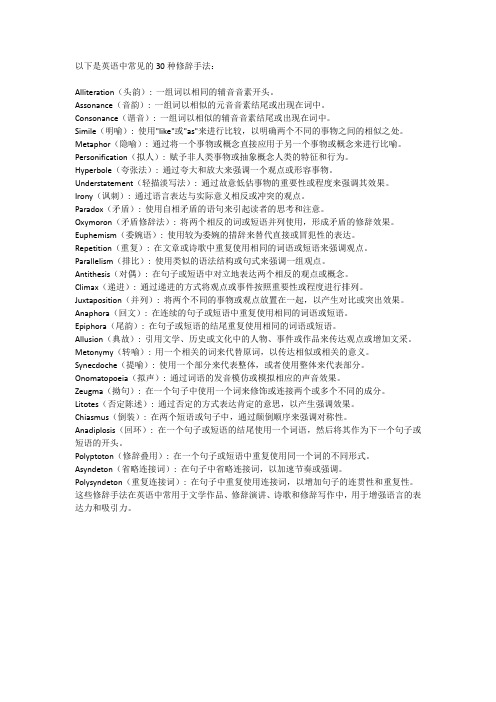
以下是英语中常见的30种修辞手法:Alliteration(头韵): 一组词以相同的辅音音素开头。
Assonance(音韵): 一组词以相似的元音音素结尾或出现在词中。
Consonance(谐音): 一组词以相似的辅音音素结尾或出现在词中。
Simile(明喻): 使用"like"或"as"来进行比较,以明确两个不同的事物之间的相似之处。
Metaphor(隐喻): 通过将一个事物或概念直接应用于另一个事物或概念来进行比喻。
Personification(拟人): 赋予非人类事物或抽象概念人类的特征和行为。
Hyperbole(夸张法): 通过夸大和放大来强调一个观点或形容事物。
Understatement(轻描淡写法): 通过故意低估事物的重要性或程度来强调其效果。
Irony(讽刺): 通过语言表达与实际意义相反或冲突的观点。
Paradox(矛盾): 使用自相矛盾的语句来引起读者的思考和注意。
Oxymoron(矛盾修辞法): 将两个相反的词或短语并列使用,形成矛盾的修辞效果。
Euphemism(委婉语): 使用较为委婉的措辞来替代直接或冒犯性的表达。
Repetition(重复): 在文章或诗歌中重复使用相同的词语或短语来强调观点。
Parallelism(排比): 使用类似的语法结构或句式来强调一组观点。
Antithesis(对偶): 在句子或短语中对立地表达两个相反的观点或概念。
Climax(递进): 通过递进的方式将观点或事件按照重要性或程度进行排列。
Juxtaposition(并列): 将两个不同的事物或观点放置在一起,以产生对比或突出效果。
Anaphora(回文): 在连续的句子或短语中重复使用相同的词语或短语。
Epiphora(尾韵): 在句子或短语的结尾重复使用相同的词语或短语。
Allusion(典故): 引用文学、历史或文化中的人物、事件或作品来传达观点或增加文采。
- 1、下载文档前请自行甄别文档内容的完整性,平台不提供额外的编辑、内容补充、找答案等附加服务。
- 2、"仅部分预览"的文档,不可在线预览部分如存在完整性等问题,可反馈申请退款(可完整预览的文档不适用该条件!)。
- 3、如文档侵犯您的权益,请联系客服反馈,我们会尽快为您处理(人工客服工作时间:9:00-18:30)。
英语修辞手法总结Figures of speech (修辞)are ways of making our language figurative. When we use words in other than their ordinary or literal sense to lend force to an idea, to heighten effect, or to create suggestive imagery, we are said to be speaking or writing figuratively. Now we are going to talk about some common forms of figures of speech.1) Simile:(明喻)It is a figure of speech which makes a comparison between two unlike elements having at least one quality or characteristic (特性)in common. To make the comparison, words like as, as...as, as if and like are used to transfer the quality we associate with one to the other. For example, As cold waters to a thirsty soul, so is good news from a far country.2) Metaphor:(暗喻)It is like a simile, also makes a comparison between two unlike elements, but unlike a simile, this comparison is implied rather than stated. For example, the world is a stage.3) Analogy: (类比)It is also a form of comparison, but unlike simile or metaphor which usually uses comparison on one point of resemblance, analogy draws a parallel between two unlike things that have several common qualities or points of resemblance.4) Personification: (拟人)It gives human form of feelings to animals, or life and personal attributes(赋予) to inanimate(无生命的) objects, or to ideas and abstractions(抽象). For example, the wind whistled through the trees.5) Hyperbole: (夸张) It is the deliberate use of overstatement or exaggeration to achieve emphasis. For instance, he almost died laughing.6) Understatement: (含蓄陈述) It is the opposite of hyperbole, or overstatement. It achieves its effect of emphasizing a fact by deliberately(故意地) understating it, impressing the listener or the reader more by what is merely implied or left unsaid than by bare statement. For instance, It is no laughing matter.7) Euphemism: (委婉) It is the substitution of an agreeable or inoffensive(无冒犯) expression for one that may offend or suggest something unpleasant. For instance, we refer to "die" as " pass away".8) Metonymy (转喻) It is a figure of speech that has to do with the substitution of the mane of one thing for that of another. For instance, the pen (words) is mightier than the sword (forces).9) Synecdoche (提喻) It is involves the substitution of the part for the whole, or the whole for the part. For instance, they say there's bread and work for all. She was dressed in silks.10) Antonomasia (换喻)It has also to do with substitution. It is not often mentioned now, though it is still in frequent use. For example, Solomon for a wise man. Daniel for a wise and fair judge. Judas for a traitor.11) Pun: (双关语) It is a play on words, or rather a play on the form and meaning of words. For instance, a cannon-ball took off his legs, so he laid down his arms. (Here "arms" has two meanings: a person's body; weapons carried by a soldier.)12) Syllepsis: (一语双叙)It has two connotations.In the first case, it is a figure by which a word, or a particular form orinflection of a word, refers to two or more words in the same sentence, while properly applying to or agreeing with only on of them in grammar or syntax(句法). For example, He addressed you and me, and desired us to follow him. (Here us is used to refer to you and me.)In the second case, it a word may refer to two or more words in the same sentence. For example, while he was fighting , and losing limb and mind, and dying, others stayed behind to pursue education and career. (Here to losing one's limbs in literal; to lose one's mind is figurative, and means to go mad.)13) Zeugma: (轭式搭配) It is a single word which is made to modify or to govern two or more words in the same sentence, wither properly applying in sense to only one of them, or applying to them in different senses. For example, The sun shall not burn you by day, nor the moon by night. (Here noon is not strong enough to burn) 14) Irony: (反语) It is a figure of speech that achieves emphasis by saying the opposite of what is meant, the intended meaning of the words being the opposite of their usual sense. For instance, we are lucky, what you said makes me feel real good.15) Innuendo: (暗讽) It is a mild form of irony, hinting in a rather roundabout (曲折)way at something disparaging(不一致) or uncomplimentary(不赞美) to the person or subject mentioned. For example, the weatherman said it would be worm. He must take his readings in a bathroom.16) Sarcasm: (讽刺) It Sarcasm is a strong form of irony. It attacks in a taunting and bitter manner, and its aim is to disparage, ridicule and wound the feelings of the subject attacked. For example, laws are like cobwebs, which may catch small flies, but let wasps break through.17) Paradox: (似非而是的隽语) It is a figure of speech consisting of a statement or proposition which on the face of it seems self-contradictory, absurd or contrary to established fact or practice, but which on further thinking and study may prove to be true, well-founded, and even to contain a succinct point. For example more haste, less speed.18) Oxymoron: (矛盾修饰) It is a compressed paradox, formed by the conjoining(结合) of two contrasting, contradictory or incongruous(不协调) terms as in bitter-sweet memories, orderly chaos(混乱) and proud humility(侮辱).19) Antithesis: (对照) It is the deliberate arrangement of contrasting words or ideas in balanced structural forms to achieve emphasis. For example, speech is silver; silence is golden.20) Epigram: (警句) It states a simple truth pithily(有利地) and pungently(强烈地). It is usually terse and arouses interest and surprise by its deep insight into certain aspects of human behavior or feeling. For instance, Few, save the poor, feel for the poor.21) Climax: (渐进) It is derived from the Greek word for "ladder" and implies the progression of thought at a uniform or almost uniform rate of significance or intensity, like the steps of a ladder ascending evenly. For example, I came, I saw,I conquered.22) Anti-climax or bathos: (突降)It is the opposite of Climax. It involves stating one's thoughts in a descending order of significance or intensity, from strong toweak, from weighty to light or frivolous. For instance, But thousands die, without or this or that, die, and endow(赋予) a college, or a cat.23) Apostrophe: (顿呼) In this figure of speech, a thing, place, idea or person (dead or absent) is addressed as if present, listening and understanding what is being said. For instance, England! awake! awake! awake!24) Transferred Epithet: (转类形容词) It is a figure of speech where an epithet (an adjective or descriptive phrase) is transferred from the noun it should rightly modify(修饰) to another to which it does not really apply or belong. For instance,I spent sleepless nights on my project.25) Alliteration: (头韵) It has to do with the sound rather than the sense of words for effect. It is a device that repeats the same sound at frequent intervals(间隔) and since the sound repeated is usually the initial consonant sound, it is also called "front rhyme". For instance, the fair breeze blew, the white foam flew, the furrow followed free.26) Onomatopoeia: (拟声) It is a device that uses words which imitate the sounds made by an object (animate or inanimate), or which are associated with or suggestive(提示的) of some action or movementExplanation version1一、什么是修辞格修辞格(figures of speech)是提高语言表达效果的语言艺术。
